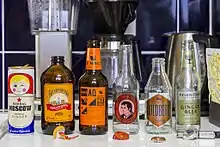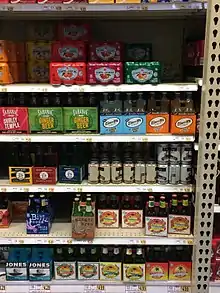Ginger beer
Traditional ginger beer is a sweetened and carbonated, usually non-alcoholic beverage. It is produced by the natural fermentation of prepared ginger spice, yeast and sugar.

Its origins date from the colonial spice trade with the Orient and the sugar-producing islands of the Caribbean.[1] It was popular in Britain and its colonies from the 18th century. Other spices were variously added and any alcohol content was limited to 2% by excise tax laws in 1855.[2] Few brewers have maintained an alcoholic product.[3]
Current ginger beers are often manufactured rather than brewed, frequently with flavor and color additives. Ginger ales are not brewed.
Ginger beer is still produced at home using a symbiotic colony of yeast and a Lactobacillus (bacteria) known as a "ginger beer plant" or from a "ginger bug" starter created from fermenting ginger, sugar, and water.[4]
History
As early as 500 BC, ginger was used as a medicine as well as for flavouring food in Ancient China and India. In the western hemisphere, ginger was used to spice up drinks. During the Victorian era, it was used to brew an alcoholic beverage termed "ginger beer".[5]
Brewed ginger beer originated in Yorkshire in England in the mid-18th century[6] and became popular throughout Britain, the United States, Ireland, South Africa and Canada, reaching a peak of popularity in the early 20th century.[7]
Brewed ginger beer was brought to the Ionian Islands by the British Army in the 19th century, and is still made as a local specialty known as tsitsibíra (τσιτσιμπίρα) by villagers in rural Corfu.[8]
Production
Alcoholic ginger beer
Brewed ginger beer originated in the UK, but is sold worldwide. Crabbie's is a popular brand in the UK.[9] It is usually labelled "alcoholic ginger beer" to distinguish it from the more established commercial ginger beers, which are not brewed (fermented), but carbonated with pressurized carbon dioxide.[10]
Ginger beer plant

The ginger beer plant (GBP), also known as "bees wine", "Palestinian bees", "Californian bees", and "balm of Gilead",[11][12] is not what is usually considered a plant but a composite organism comprising the yeast Saccharomyces florentinus (formerly S. pyriformis) and the bacterium Lactobacillus hilgardii (formerly Brevibacterium vermiforme),[13][14] which form a symbiotic culture of bacteria and yeast (SCOBY). It forms a gelatinous substance that allows it to be easily transferred from one fermenting substrate to the next, much like kefir grains, kombucha, and tibicos.[15] The GBP was first described by Harry Marshall Ward in 1892, from samples he received in 1887.[14][16][17] Original ginger beer is brewed by leaving water, sugar, ginger, optional ingredients such as lemon juice and cream of tartar, and GBP to ferment for several days, converting some of the sugar into alcohol. GBP may be obtained from several commercial sources. Until about 2008 laboratory-grade GBP was available only from the yeast bank Deutsche Sammlung von Mikroorganismen und Zellkulturen in Germany (catalogue number DMS 2484),[12] but the item is no longer listed. The National Collection of Yeast Cultures (NCYC) had an old sample of "Bees wine" as of 2008, but current staff have not used it, and NCYC are unable to supply it for safety reasons, as the exact composition of the sample is unknown.[12]
In the UK, the origins of the original ginger beer plant is unknown. When a batch of ginger beer was made using some ginger beer "plant" (GBP), the jelly-like residue was also bottled and became the new GBP. Some of this GBP was kept for making the next batch of ginger beer, and some was given to friends and family, so the plant was passed on through generations. Following Ward's research and experiments, he created his own ginger beer from a new plant that he had made, and he proposed, but did not prove, that the plant was created by contaminants found on the raw materials, with the yeast coming from the raw brown sugar and the bacteria coming from the ginger root.[18]
Yeast starter
A ginger beer starter can be made by fermenting a mixture of water, brewer's or baker's yeast (not the SCOBY described above), ginger, and sugar; this is kept for a week or longer, with sugar regularly added, e.g., daily, to increase alcohol content. More ginger may also be added. When finished, this concentrated mix is strained, diluted with water and lemon juice, and bottled.[19][20][21][22][23][24] This is the process used by commercial ginger beer makers. Ginger beer made from a yeast-based starter is reported to not have the same taste or mouth feel as that made with ginger beer plant. And it must be noted the near-complete loss of the ginger beer plant is likely due to the decrease in home brewing and the increased commercial production of ginger beer in the late 1800s and early 1900s. Large-scale breweries favored the use of yeast, as used in conventional beer-making, because of ease for scaled production.
Ginger beer soft drink
Non-alcoholic ginger beer is a type of carbonated soft drink flavoured with ginger. An example is Stoney, a product of The Coca-Cola Company widely sold in southern and eastern Africa.[25]
Mixed drinks
The ginger beer soft drink may be mixed with beer (usually a British ale of some sort) to make one type of shandy, or with dark rum to make a drink, originally from Bermuda, called a Dark 'N' Stormy. It is the main ingredient in the Moscow Mule cocktail (although in some cases ginger ale is used as an alternative, where ginger beer is not available).
See also
- Ginger ale
- Crabbie's
- Root beer
- Barritt's Ginger Beer
- Sockerdricka
- Caribbean cuisine
- Ginger wine
- Canton (liqueur)
- Socată
- List of soft drink flavors
- Donoghue v. Stevenson, legal case involving ginger beer
References
- "Old Jamaica". Retrieved 21 May 2016.
- "Barritts Ginger Beer". Retrieved 21 May 2016.
- "Story - Crabbies Ginger Beer". Retrieved 21 May 2016.
- Ginger Bug - Zero Waste Chef
- "The Old Fashioned Way: Homemade Ginger Beer". Tori Avey. Retrieved 21 May 2016.
- Thomas Sprat (1702) A history of the Royal Society of London, page 196 "of Brewing Beer with Ginger instead of Hops"
- Donald Yates (Spring 2003). "Root Beer and Ginger Beer heritage". Archived from the original on 2008-08-21. Retrieved 2006-12-06.
- Nick Edwards & John Gill, "The Rough Guide to Corfu." Rough Guides (2003) p.87
- Bassett, Win (November 15, 2012). "Crabbie's, The Original Alcoholic Ginger Beer, Debuts in United States". All About Beer Magazine. Retrieved 24 November 2013.
- Knowlton, Andrew (January 22, 2013). "A Bottle in Front of Me Crabbie's". BON APPÉTIT. Retrieved 24 November 2013.
- Kebler, Lyman F. (1921). "California Bees, a paper submitted by L.F. Kebler to the American Pharmaceutical Association". Journal of the American Pharmaceutical Association. 10 (12): 939–943. doi:10.1002/jps.3080101206.
- "Beeswine". National Collection of Yeast Cultures. Archived from the original on 17 May 2008.
- "Ginger — ginger beer plant". Plant Cultures. 16 June 2006. Archived from the original on 21 October 2012. Retrieved 2012-09-15.
- "Lactic Acid Beverages: sour beer, (milk) & soda" (PDF). 22 June 2006. Archived from the original (PDF) on 15 January 2007. Retrieved 2006-12-06.
- Walter Donald Daker; Maurice Stakey (14 September 1938). "CCLI. Investigation of a Polysaccharide Produced From Sucrose by Betabacterium Vermiformé (Ward-Meyer)". Biochem. J. 32 (11): 1946–8. doi:10.1042/bj0321946. PMC 1264278. PMID 16746831.
- "Harry Marshall Ward : Biography". Retrieved 2006-12-06.
- Vines, Gail (28 September 2002). "Marriage of equals". New Scientist (2362): 50. Alternative source
- "The Ginger-Beer Plant (Paper presented by Prof. Ward to the Royal Society 1892)" (PDF). The Royal Society Publishing.
- Burke's Backyard Ginger Beer Fact Sheet
- ABC Radio - Recipes Ginger Beer
- Warwick Daily News, 12 Nov 1951 How to Start a Ginger Beer Plant
- Science in School Ginger beer: a traditional fermented low-alcohol drink
- Western Mail, 9 Apr 1953 Ginger Beer Plant
- The Western Australian, 9 Dec 1947 Starting a Ginger Beer Plant
- "Stronger than the strongest thirst". Coca Cola South Africa. Retrieved 23 February 2012.
External links
| Wikimedia Commons has media related to Ginger beer. |
| Wikibooks Cookbook has a recipe/module on |
- Of the Street Sale of Ginger-Beer, Sherbet, Lemonade,&C., from London Labour and the London Poor, Volume 1, Henry Mayhew, 1851; subsequent pages cover the costs and income of street ginger beer sellers.
- http://www.scienceinschool.org/sites/default/files/issuePdf/issue8.pdf